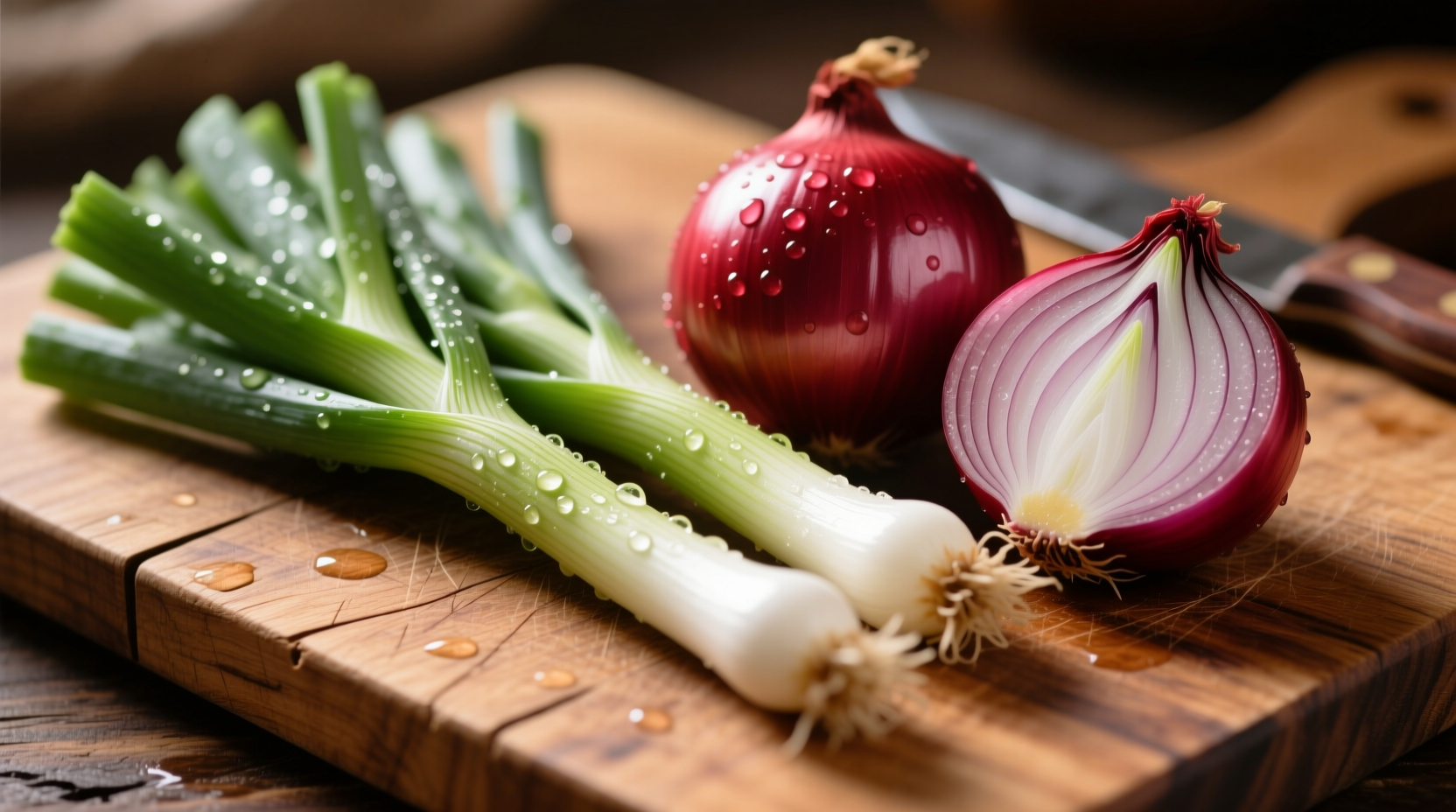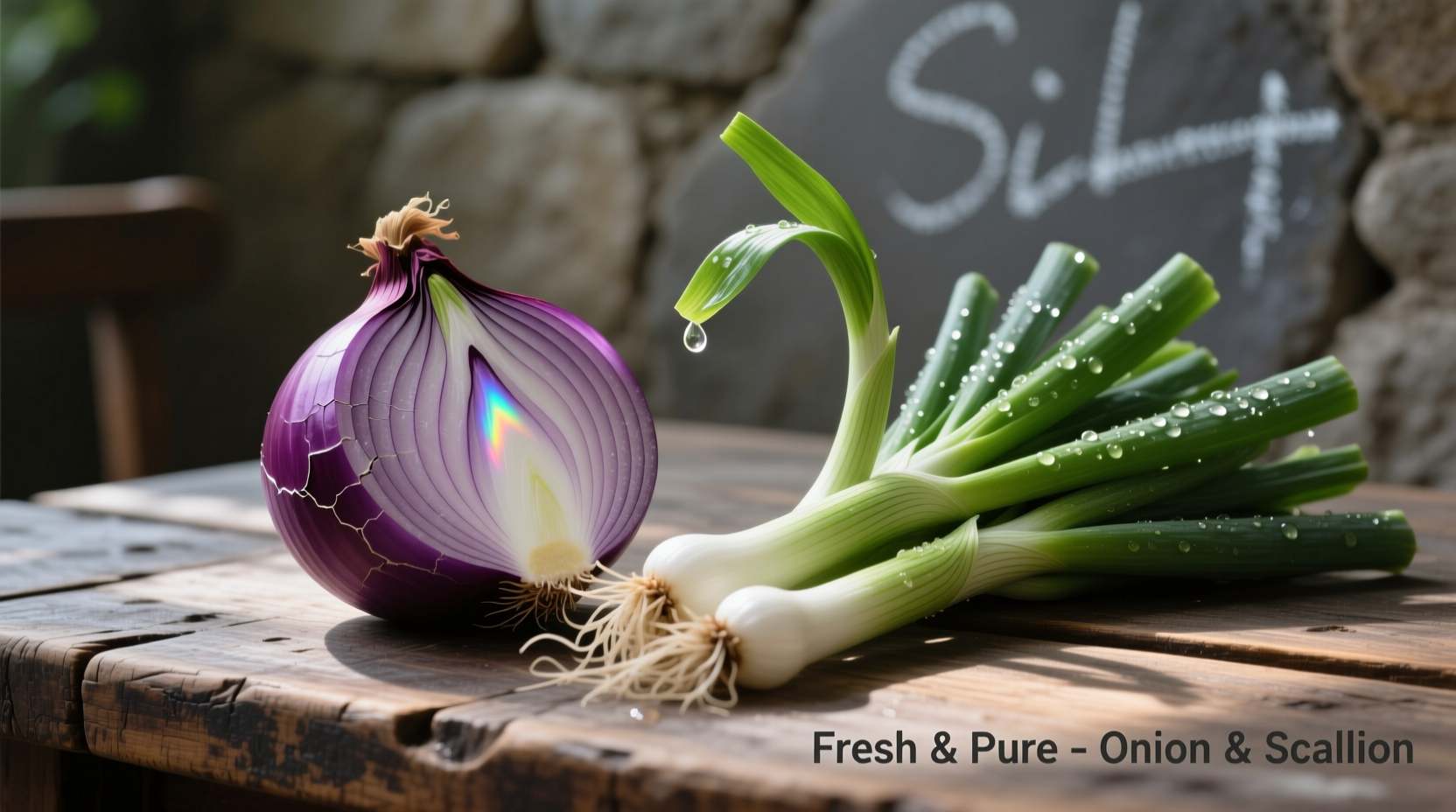Onions and scallions (green onions) belong to the Allium family but differ fundamentally in structure, flavor intensity, and culinary applications. True onions develop substantial bulbs with concentrated sulfur compounds creating pungent flavors, while scallions are harvested young with slender white bulbs and edible green stalks offering milder, fresher taste. Understanding these distinctions prevents recipe failures—using mature onions in place of scallions creates overpowering heat, while substituting scallions for caramelized onions lacks depth. This guide reveals exactly when to use each variety for optimal results in your cooking.
Decoding the Allium Family: Onion vs Scallion Fundamentals
Many home cooks mistakenly treat onions and scallions as interchangeable, leading to disappointing dishes. The critical difference lies in their growth stage and chemical composition. Onions (Allium cepa) mature fully, developing layered bulbs that concentrate allyl sulfides—the compounds responsible for their sharp bite and tear-inducing properties. Scallions (Allium fistulosum or young Allium cepa), harvested before bulb formation, contain significantly lower sulfur concentrations, yielding delicate flavor throughout both white and green portions.
| Characteristic | Onion (Mature Bulb) | Scallion (Green Onion) |
|---|---|---|
| Botanical Classification | Allium cepa (bulbing type) | Allium fistulosum or immature Allium cepa |
| Physical Structure | Dense, layered bulb; dry papery skin; inedible stalks | Slender white bulb (1-2" diameter); crisp green stalks |
| Flavor Profile | Sharp, pungent when raw; sweetens dramatically when cooked | Mild, fresh onion flavor throughout; subtle garlic notes in some varieties |
| Best Culinary Applications | Caramelizing, soups, stews, roasting, grilling | Garnishes, stir-fries, salads, egg dishes, finishing touches |
| Storage Life | 1-2 months in cool, dark place (per USDA Food Safety guidelines) | 3-5 days refrigerated in perforated bag |
When Flavor Matters: Strategic Ingredient Selection
Your choice between onions and scallions should align with the dish's flavor development timeline. Mature onions excel in recipes requiring flavor foundation building—their complex sugars caramelize beautifully, creating rich umami bases for sauces and braises. As Cornell University's Food Science department confirms, the Maillard reaction in cooked onions produces over 500 flavor compounds that scallions cannot replicate.
Scallions shine where fresh, bright notes are essential. Their entire plant remains edible, providing textural contrast in dishes like Asian stir-fries or Mexican pico de gallo. Professional chefs consistently add scallions after cooking to preserve their delicate flavor—a technique documented in culinary research from the Culinary Institute of America. Substitute scallions for mature onions only in raw applications like salads, and never vice versa in finishing dishes.

Nutritional Nuances You Should Know
While both provide vitamin C and antioxidants, their nutritional profiles differ significantly. According to USDA FoodData Central, 100g of raw onion contains 40 calories and 9g carbohydrates, while scallions provide just 32 calories and 7g carbs. Scallions deliver 2.5 times more vitamin K and twice the vitamin A—critical for bone health and vision. Onions, however, contain higher quercetin levels, a flavonoid with potent anti-inflammatory properties studied by the National Institutes of Health.
Mastering Selection and Storage
Choosing quality specimens: Select onions with firm, dry skins free of sprouts—soft spots indicate decay. For scallions, look for crisp, vibrant green stalks with white roots still attached; yellowing indicates age. The University of California Cooperative Extension emphasizes that scallions with thicker white bulbs (up to 1 inch) offer better flavor balance.
Proper storage techniques: Keep mature onions in mesh bags in cool, dark places—never refrigerate as moisture accelerates spoilage. Store scallions upright in a glass with 1 inch of water, covered with a plastic bag in the refrigerator. Change water every two days to extend freshness up to 10 days, per FDA food safety recommendations.
Avoiding Common Culinary Mistakes
Even experienced cooks make these critical errors:
- Using scallions for caramelizing: Their low sugar content prevents proper browning. Stick with yellow or red onions for this technique.
- Discarding scallion greens: The dark green portions contain concentrated nutrients—finely chop for garnishes or blend into sauces.
- Substituting ratios incorrectly: When replacing onions with scallions, use 3 parts scallions for every 1 part mature onion to compensate for milder flavor.
- Overcooking scallions: Add them during the last 2 minutes of cooking to preserve texture and flavor.
Global Culinary Applications
Cultures worldwide leverage these alliums differently based on their unique properties:
- French cuisine: Shallots (a close onion relative) form the base for sauces, while scallions finish delicate omelets
- Chinese cooking: Scallion oil (cong you) uses both white and green parts, while mature onions appear in Western-influenced dishes
- Mexican tradition: White onions dominate salsas and grilled meats; scallions feature in guacamole and seafood ceviche
- Middle Eastern preparations: Red onions pickle beautifully for salads; scallions enhance fresh herb mixes like zhug
Practical Substitution Guide
When ingredients are unavailable, these evidence-based swaps maintain dish integrity:
- Onion substitute: 1 cup chopped shallots + ¼ tsp garlic powder (closest flavor profile)
- Scallion replacement: ½ cup finely sliced leeks (white part only) + 2 tbsp chives
- Emergency swap: For raw applications, use ¾ cup jicama matchsticks with lemon zest for crunch
Never substitute dried onion powder for fresh scallions—it lacks the necessary moisture and fresh flavor components.
Frequently Asked Questions
Can I use scallions instead of onions in soup?
Yes, but only if added near the end of cooking. Scallions lack the sugar content needed for flavor development in long-simmered soups. For best results, use 1½ times the amount of scallions and add them during the last 10 minutes to preserve their delicate flavor.
Why do scallions taste milder than regular onions?
Scallions are harvested before bulb formation, resulting in lower concentrations of sulfur compounds that create pungency. Their younger age means less time for flavor-concentrating compounds to develop, giving them a fresher, grassier taste profile throughout both white and green portions.
How do I prevent crying when cutting onions?
Chill onions for 30 minutes before cutting to slow enzyme activity. Use a sharp knife to minimize cell damage, and cut under running water or near a fan to disperse the volatile compounds. Never use scallions as a tear-free alternative—they serve different culinary purposes.
Are spring onions the same as scallions?
No. Spring onions have larger, rounder bulbs (about the size of a ping pong ball) and pinkish bases, with more pronounced onion flavor. True scallions have slender, white bulbs without significant swelling and milder taste throughout. They're often mislabeled in grocery stores.











 浙公网安备
33010002000092号
浙公网安备
33010002000092号 浙B2-20120091-4
浙B2-20120091-4